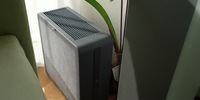

Oh, Selina! You do so little, and yet I love you!
No app. Only three values on the display. Selina doesn’t even have a radio-controlled clock. Nevertheless, Stadler Form’s device is a favourite at home.
A healthy indoor environment requires a certain relative humidity – ideally between 40 and 60 per cent. If it’s lower, you’ll feel it in your nose, for example. Your mucous membranes are too dry, making you more susceptible to colds. If the air is too humid, mould can form in the room in the worst case. Relative humidity is therefore quite important for your well-being.
However, hygrometers, i.e. devices for measuring humidity, often receive less attention than thermometers. The preference for temperature gauges is even reflected in our range. The product type is called Thermometers + Hygrometers,
thermometers come first.
It’s high time I showed you a hygrometer I’ve grown fond of. The little thing is called Selina. Selina is either small, around five centimetres high, or large, around twice as tall at just under ten centimetres. It was created by Stadler Form, a Swiss manufacturer of all kinds of appliances for good indoor air. Selina does exactly what Stadler’s humidifiers do too. They have built-in hygrometers, but it’s not a two-way street.
Selina doesn’t humidify the air. In truth, it only displays three things:
- Temperature
- Air humidity
- Time
Humidity is its main discipline, shown most prominently on the semitransparent LC display. There’s also a smiley face, smiling with satisfaction when the value is between 40 and 60 per cent. Otherwise, it looks at me sadly.
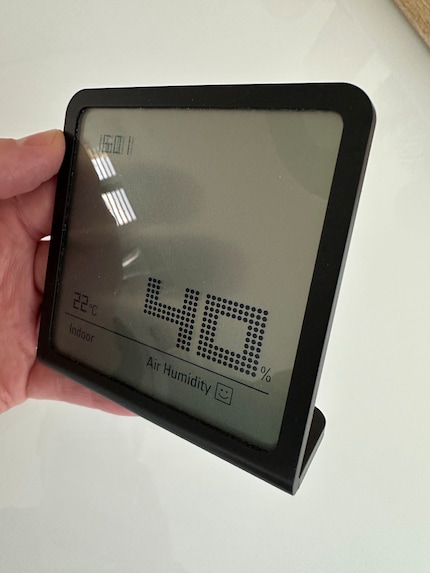
Source: Martin Jungfer
A smaller display to the left shows the current temperature. The time is shown in the top left-hand corner. That’s it. More than half of the display area on the large model I tested is empty. And I love it. I don’t want an overloaded data cockpit.
Stadler Form has streamlined Selina for simplicity so consistently that there’s no option to configure the display. It is what it is. Feels a bit like the iPhone in 2015, when there was nothing to customise either. But at least the iPhone had a bright display back then – Selina doesn’t even have that. I can’t read the display in the dark.
There isn’t even an app for Selina. It doesn’t need to be connected to your home Wi-Fi, no data is collected and processed into animated line diagrams.
I can concentrate fully on finding a suitable place for Selina in my living room. A spot that does justice to its design. Selina is a slim beauty made of matt plastic, with a display and stand just over four millimetres thick. They’re at an angle of 80 degrees to each other and grant Selina stability and grace. The best place is on a chest of drawers or a kitchen bar, for example. You should avoid direct sunlight, draughts or insufficient air circulation. Not for design reasons, but for very practical ones.
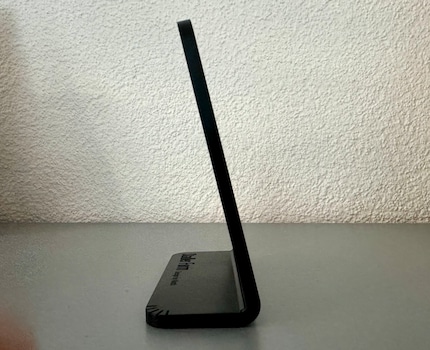
Source: Martin Jungfer
Location: avoid the sun and draughts
Selina doesn’t only cut a fine figure in the right location. More importantly, it delivers much more precise values this way. Manufacturer Stadler Form states that the sensor operates within a tolerance range of plus or minus three per cent. I can confirm this after a comparison with other measuring devices. Selina was always very close to the values stated by significantly more expensive professional measuring devices.
Selina draws energy for her precise daily work from a CR2032 battery in the stand. In my case, the button cell easily lasts a year. To change it, I need a coin to open the battery compartment. It’s amazing there’s even room, given that the battery’s almost as high as Selina’s entire stand.
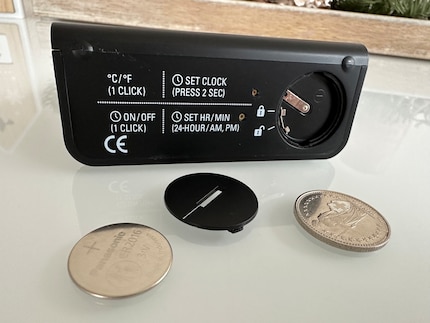
Source: Martin Jungfer
Selina’s only controls are also located at the bottom of the base. There are two indentations that react to pressure. The end of a bent paper clip or the tip of a ballpoint pen are good options here. I use one of these tools exactly twice a year, whenever it’s time to switch from summer to winter time or vice versa. Yep, you’ve guessed it: Selina doesn’t have a radio-controlled clock. For once, however, adjusting the time here doesn’t drive me crazy. The function of both buttons is clearer and easier to understand than I’ve ever seen before.
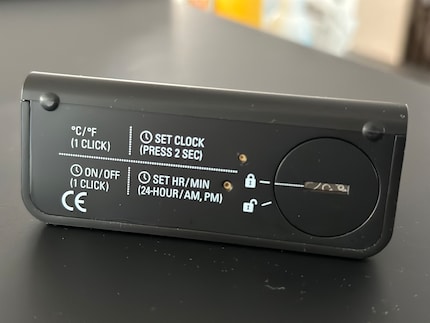
Source: Martin Jungfer
Verdict: does (almost) nothing, but still great at its job
This hygrometer does almost nothing. But Selina turns it into an art form. If you do almost nothing, it’s hard to actually annoy your users. I gratefully accept the fact I can assign Selina her spot and she’ll work there completely unobtrusively for many months. I don’t miss anything. If I’m interested in the humidity, I check the value at a glance, know that it’s just right – and enjoy the great design as a bonus.
Of course, I’m already expecting someone in the comments to tell me that I could get a hygrometer from somewhere in China for way less money. I know. But I also know that someone who creates something beautiful from an inane yet useful helper, namely a hygrometer, also has to earn a living. I’ll very gladly pay for that.
Header image: Martin Jungfer
Journalist since 1997. Stopovers in Franconia (or the Franken region), Lake Constance, Obwalden, Nidwalden and Zurich. Father since 2014. Expert in editorial organisation and motivation. Focus on sustainability, home office tools, beautiful things for the home, creative toys and sports equipment.


